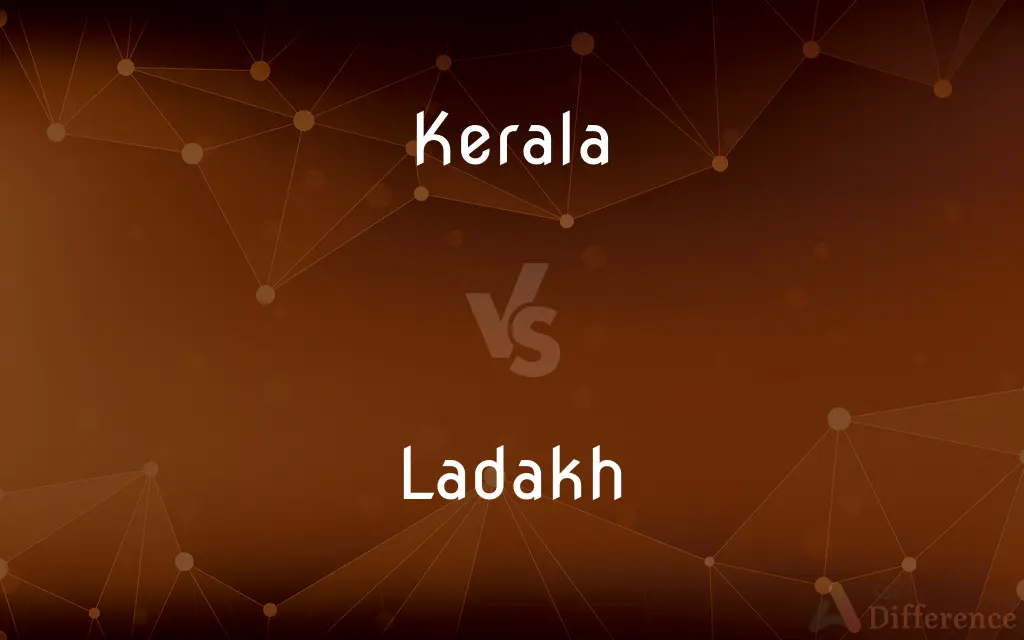Kerala vs. Ladakh — What's the Difference?
Edited by Tayyaba Rehman — By Maham Liaqat — Updated on March 25, 2024
Kerala is a lush, tropical state in southern India known for its backwaters and cultural heritage, whereas Ladakh, located in the northern part of India, is renowned for its stark desert landscapes, Buddhist monasteries, and high-altitude terrain.

Difference Between Kerala and Ladakh
Table of Contents
ADVERTISEMENT
Key Differences
Kerala, often referred to as "God's Own Country," is situated in the southwestern part of India, characterized by its extensive network of backwaters, palm-lined beaches, and the Western Ghats' spice and tea-covered hills. Its climate is tropical, with significant rainfall contributing to its dense forests and rich biodiversity. In contrast, Ladakh, nestled between the Kunlun mountain range in the north and the main Great Himalayas to the south, is known for its arid landscape, cold desert, and stunning high-altitude lakes like Pangong Tso. Ladakh's climate is significantly colder, with long, harsh winters and short, cool summers, reflecting its high-altitude desert environment.
While Kerala's culture is a vibrant tapestry that includes traditional Kathakali and Mohiniyattam dances, annual boat races, and the Onam festival, Ladakh's culture is deeply influenced by Tibetan Buddhism, visible in its numerous monasteries, festivals like Hemis Tsechu, and its architectural styles. Kerala's cuisine, rich in spices and flavors, features seafood and coconut prominently, reflecting its coastal geography. On the other hand, Ladakh's cuisine is adapted to its cold desert climate, with a focus on meat, dairy products, and barley, essential for surviving the cold.
Kerala's economy is driven by tourism, agriculture (notably spices, tea, and rubber), and remittances from overseas workers, showcasing its diverse economic activities. Ladakh, having gained union territory status in 2019, has an economy primarily based on agriculture, tourism, and the military, with a significant emphasis on sustainable tourism and the preservation of its unique cultural heritage and natural landscape.
The biodiversity in Kerala includes a wide range of flora and fauna, with numerous national parks and wildlife sanctuaries such as Periyar and Silent Valley, home to elephants, tigers, and exotic birds. Ladakh, while more barren, hosts unique wildlife adapted to its high-altitude environment, including the snow leopard, Tibetan antelope, and wild yak, with conservation areas like the Hemis National Park.
Both regions, despite their contrasting climates and landscapes, are integral to India's cultural and natural diversity. Kerala offers a lush, tropical experience with a focus on water-based activities and green landscapes, while Ladakh presents a serene, rugged beauty with opportunities for trekking, mountain biking, and exploring Tibetan Buddhist culture.
ADVERTISEMENT
Comparison Chart
Geography
Tropical, with backwaters and lush greenery.
High-altitude desert, stark landscapes.
Climate
Tropical monsoon, with heavy rainfall.
Cold desert climate, with extreme temperature variations.
Culture
Rich in classical arts, festivals, and cuisine.
Influenced by Tibetan Buddhism, with distinct festivals and architecture.
Cuisine
Spicy, with an emphasis on seafood and coconut.
Focus on meat, dairy, and barley.
Economy
Driven by tourism, agriculture, and remittances.
Based on agriculture, tourism, and military presence.
Wildlife
Diverse, with elephants, tigers, and exotic birds.
Adapted to cold, including snow leopards and wild yaks.
Key Attractions
Backwaters, hill stations, and beaches.
Buddhist monasteries, high-altitude lakes, and trekking routes.
Festivals
Onam, Thrissur Pooram, boat races.
Hemis Tsechu, Losar Festival.
Language
Malayalam.
Ladakhi, Tibetan, Hindi.
Tourism Focus
Cultural heritage, ecotourism, and wellness retreats.
Adventure tourism, cultural tours, and ecotourism.
Compare with Definitions
Kerala
A tropical paradise in southern India.
Kerala is famous for its tranquil backwaters.
Ladakh
A destination for adventure tourism.
Ladakh is a popular spot for trekking and mountain biking.
Kerala
Known for its Ayurvedic treatments.
Many visit Kerala for its rejuvenating Ayurvedic resorts.
Ladakh
Offers unique wildlife sightings.
The snow leopard is a sought-after sight in Ladakh's Hemis National Park.
Kerala
Rich in cultural festivals.
Kerala's Onam celebration showcases its rich cultural heritage.
Ladakh
A high-altitude desert region.
Ladakh's landscape is marked by rugged mountains and clear blue lakes.
Kerala
Diverse in flora and fauna.
The Western Ghats in Kerala are a biodiversity hotspot.
Ladakh
Renowned for Buddhist monasteries.
Thiksey Monastery is a major attraction in Ladakh.
Kerala
A hub for spice and tea plantations.
Kerala's hills are adorned with spice and tea gardens.
Ladakh
Influenced by Tibetan culture.
Ladakh celebrates Tibetan festivals with great zeal.
Kerala
Kerala (English: ; Malayalam: [ke:ɾɐɭɐm] (listen)) is a state on the Malabar Coast of India. It was formed on 1 November 1956, following the passage of the States Reorganisation Act, by combining Malayalam-speaking regions of the erstwhile regions of Cochin, Malabar, South Canara, and Travancore.
Ladakh
Ladakh is a region administered by India as a union territory, and constitutes a part of the larger Kashmir region, which has been the subject of dispute between India, Pakistan, and China since 1947. It was established on 31 October 2019, following the passage of the Jammu and Kashmir Reorganisation Act.
Kerala
A state on the coast of south-western India; capital, Thiruvananthapuram. It was created in 1956 from the former state of Travancore-Cochin and part of Madras.
Common Curiosities
What are the best times to visit Ladakh?
The best time to visit Ladakh is from May to September when the weather is most conducive for tourism.
Why is Ladakh a popular tourist destination?
Ladakh attracts tourists for its stunning high-altitude landscapes, Buddhist cultural heritage, and adventure tourism opportunities.
How do the cultures of Kerala and Ladakh differ?
Kerala's culture is diverse with influences from Hinduism, Christianity, and Islam, celebrated through various festivals and art forms, while Ladakh's culture is deeply influenced by Tibetan Buddhism, visible in its monasteries, festivals, and daily life.
What kind of adventure activities can tourists do in Ladakh?
Tourists can engage in trekking, mountain biking, river rafting, and camping in Ladakh's rugged terrain.
What wildlife can be found in Ladakh?
Ladakh is home to unique wildlife like the snow leopard, Tibetan antelope, and wild yak, adapted to its cold desert environment.
How do conservation efforts in Kerala compare with those in Ladakh?
Kerala's conservation efforts are focused on preserving its biodiversity through protected areas and wildlife sanctuaries. In contrast, Ladakh's conservation initiatives are geared towards safeguarding its unique high-altitude ecosystem and endangered species, such as the snow leopard.
Can you experience snow in Kerala?
No, Kerala's tropical climate does not allow for snowfall. It is known for its warm weather and lush greenery.
What are the main economic activities in Kerala?
Tourism, agriculture (spices, tea, rubber), and remittances from overseas workers are Kerala's main economic activities.
What makes Kerala unique?
Kerala's unique combination of lush landscapes, backwaters, rich cultural heritage, and Ayurvedic wellness retreats sets it apart.
How does the cuisine in Kerala differ from Ladakh?
Kerala's cuisine is rich in spices and coconut, often featuring seafood, while Ladakh's cuisine is hearty, with more emphasis on meat, dairy, and barley to adapt to the cold climate.
Is Ladakh accessible throughout the year?
Ladakh is generally accessible by air throughout the year, but road access via the Manali-Leh and Srinagar-Leh highways is subject to seasonal weather conditions, typically open from May to October.
Can you experience traditional village life in both Kerala and Ladakh?
Yes, both Kerala and Ladakh offer opportunities to experience traditional village life, with homestays and community-based tourism initiatives that allow visitors to immerse themselves in the local culture, cuisine, and daily activities.
What role does religion play in the cultural life of Kerala and Ladakh?
Religion plays a significant role in both regions, with Kerala's culture influenced by Hinduism, Christianity, and Islam, and Ladakh's culture deeply rooted in Tibetan Buddhism. Religious festivals, rituals, and places of worship are central to the cultural identity of both Kerala and Ladakh.
What are some cultural similarities between Kerala and Ladakh?
Both regions have a strong tradition of festivals that are deeply ingrained in their cultural identity, though the nature and origins of these festivals differ significantly, reflecting their unique historical and cultural backgrounds.
Share Your Discovery

Previous Comparison
Unfortunate vs. Unfortunately
Next Comparison
Lbf vs. LbsAuthor Spotlight
Written by
Maham LiaqatEdited by
Tayyaba RehmanTayyaba Rehman is a distinguished writer, currently serving as a primary contributor to askdifference.com. As a researcher in semantics and etymology, Tayyaba's passion for the complexity of languages and their distinctions has found a perfect home on the platform. Tayyaba delves into the intricacies of language, distinguishing between commonly confused words and phrases, thereby providing clarity for readers worldwide.
















































